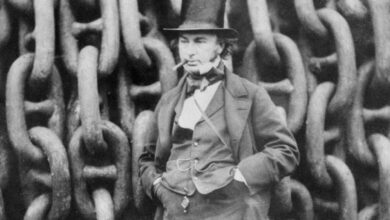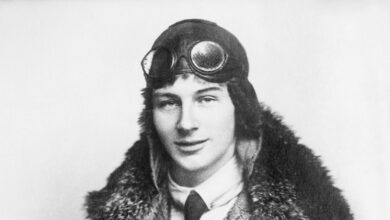
Podcast: Play in new window | Download
Subscribe: Spotify | Amazon Music | Youtube Music | RSS
“I have not failed. I’ve just found 10,000 ways that won’t work.” – Thomas Edison
Thomas Alva Edison was born on 11 February 1847 in Milan, Ohio, USA, but in 1854, the family moved to Port Huron, Michigan due to his father, Samuel getting a job there. Thomas was the youngest of seven children and was mostly taught at home by his mother Nancy who had been a schoolteacher, but he did occasionally attend a local school, although he very quickly would become bored and was labelled a misfit
From the age of about 12 Thomas started to develop hearing problems and eventually would become totally deaf in one year with only slight hearing in the other. The cause of his deafness was attributed to the fact that he had contracted scarlet fever when he was younger. He was an inquisitive child though and learned a lot of what he knew through reading and performing small experiments. He was especially interested in technology.
In 1859 Thomas quit school altogether and started earning money selling newspapers and snacks on the trains that ran between Detroit and Port Huron. By the time he became a teenager, he was earning about $50 per week, most of which he spent on equipment for different experiments he was conducting. During his time on the railway, he was taught how to use the telegraph by station agent J. U. Mackenzie as a thank you for saving his son’s life, which Edison had done by pulling him out of the way of a runaway train.
However, the move away from dots and dashes being recorded on strips of paper which Edison had learned to read, and towards the use of sound left Edison at a disadvantage due to his poor hearing. He spent a lot of his time trying to invent or improve equipment so that he could continue to use it and started to conclude that he should become a full-time inventor and engineer. This decision led to him receiving his first patent on 1 June 1869 which was for an electric vote recorder.
With there being little call for such a machine Edison decided soon afterwards to move to New York City where he hooked up with another inventor and fellow telegrapher called Frank Leonard Pope who was also an expert in all things electrical. They went into business together and produced the Edison Universal Stock Printer as well as other printing technology whilst trying at the same time to figure out duplexing or in other words a way of sending two telegraph messages down a single wire at the same time.
In 1871 Thomas Edison married sixteen-year-old Mary Stilwell whom he had met when she gained employment in one of his shops. The couple had three children, Marion who was born in 1873, Thomas who was born in 1876 and William who was born in 1878. However, neither of the newlyweds was any good at managing finances and they soon ran into financial trouble.
An upturn was around the corner though as Edison’s work on the duplex telegraph, had turned into work on a quadruplex system, which would be able to send four simultaneous messages down a single line. His work was successful, and he sold the technology to Western Union for $10,000 with the money being was used to build a new research facility and machine shop at Menlo Park, which is about 12 miles south of Newark in New Jersey.
A significant number of ideas and discoveries came out of Menlo Park and although he had a lot of people working for him, it was Edison’s name that went on the patents, 1093 of them in total. Some of the things he invented were because he identified a need and then went looking for an answer, whereas other things were just stumbled upon. One of these inventions was the phonograph which was the result of Edison’s efforts to invent a machine that could transcribe telegraph signals.
Another example came about as a byproduct of his efforts, on behalf of other scientists, to invent a device that was able to detect exceedingly small temperature changes during a solar eclipse. He turned to one of his earlier inventions known as the carbon button to help him with the task. The result was a device called a microtasimeter which he altered to enable the current to be controlled in electric arc lights to prevent the source of the light from being destroyed by the current passing through it. After convincing people with deep pockets that he had devised technology that would allow for safe electrical lighting that would replace gas lamps, he formed the Edison Electric Light Company and with backing from the likes of J. P. Morgan and the Vanderbilt family, the outcome of the work was an early version of the first electric lightbulb. Not only that, he developed a way for the bulb to be connected to an electrical circuit in parallel so that if it failed, any other bulbs connected to the circuit would continue to work. The first land-based incandescent lighting system was installed at a New York printing firm in January 1881.
On 9 August 1884, Edison’s wife, Mary died. It’s not 100% clear what the cause was but it was likely either a brain tumor or possibly a morphine overdose. With three young children on his hands and a laboratory to run, he needed help and so looked to marry again settling on the 20-year-old Mina Miller, whom he married on 24 February 1886, when he was 39. Mina provided Edison with three more children, Madeleine who was born in 1888, Charles who was born in 1890 and Theodore who was born in 1898. The couple moved to a new property on a hilltop estate in West Orange New Jersey and Edison built a new laboratory nearby. More commercially viable inventions followed such as the alkaline storage battery as well as improvements on others such as the phonograph which eventually became commercially viable.
Thomas Edison died at the age of 84 on 18 October 1931 due to complications associated with diabetes. He left behind a legacy of creation and invention in the fields of mass communications, music and film, electricity and electric lighting thus laying the foundations of the technological and social revolution that was yet to come.
Podcast: Play in new window | Download
Subscribe: Spotify | Amazon Music | Youtube Music | RSS




